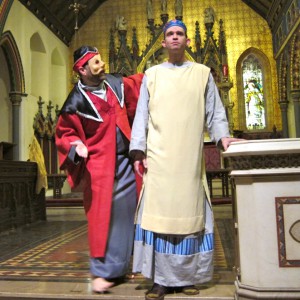Composed in 1967/68, Benjamin Britten’s chamber opera “The Prodigal Son” is subtitled “A Parable for Church Performance.” And The Church of the Transfiguration, also known as “The Little Church Around the Corner,” proved to be a perfect venue in which to hear this superlative performance. With its all-male cast and its use of masks and stylized movement, the work shows the influence of Japanese Nō drama. In addition, the use of small drums, bells and gong all conjure up the sound of the music of the Far East.
The work began with the sound of chant far in the distance, a foolproof way of setting the mood for chamber opera performed in a church. The chanters, hooded monks, soon processed down the center aisle and assembled in the sanctuary. After the four main characters (The Father, The Elder Son, The Younger Son, The Tempter/Abbot) removed their monk’s habits and put on their costumes, the drama began to the accompaniment of the organ and chamber orchestra.
What followed was a performance that succeeded in all aspects. The four soloists were superb, each singing with dramatic intensity, great sound and crystal-clear diction. As the Tempter, David Neer had the meatiest part and skillfully expressed the character’s unctuous villainy. Peter Ludwig’s portrayal of The Father expertly balanced self-satisfied pomposity and deep paternal love. And as the two sons, Reid Pierre Delahunt and Christopher Preston Thompson clearly contrasted the two young men’s world view. Each soloist was a fine singing-actor.
Some of the men performing the roles of monks, servants, parasites and beggars, and all of the boys portraying “distant voices” were members of the church’s Choir of Men and Boys. They all sang with great tone and strong sense of ensemble. Highest praise must go to Music Director Claudia Dumschat who lead the fine chamber orchestra and performed the all-pervasive organ part. Under her leadership, the musical preparation and execution were exemplary. Mention should also be made of the simple but quite evocative costumes by Costume Designer Terri Bush. The dramatic action, responsibility of Dramaturg/Stage Manager Betty Howe and Stage Director Richard Olson, was persuasive and melded seamlessly with the singing. All in all, a wonderful performance.

